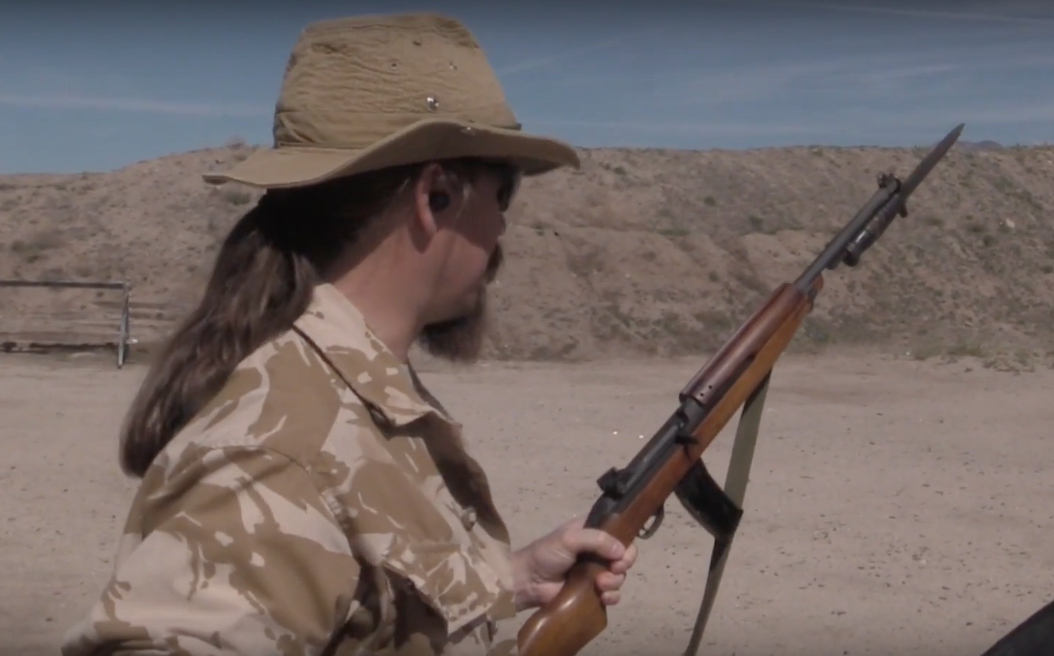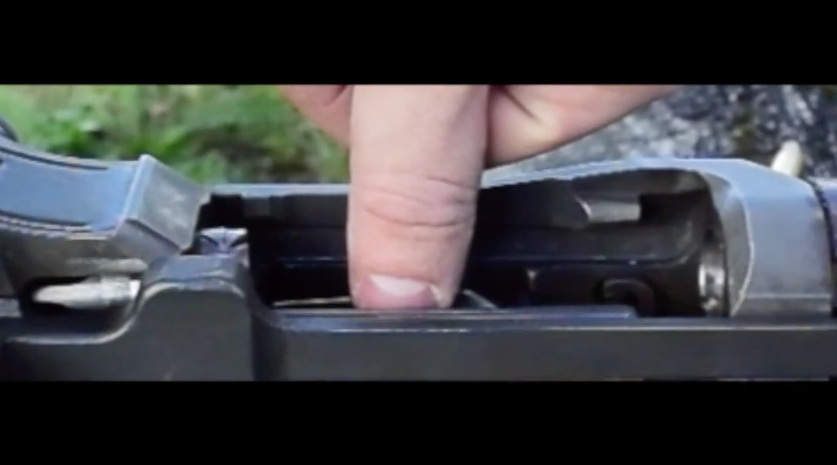The UD-42 was originally the design of Carl “Gus” Swebilius, who was at the time (1940) working for the High Standard company. It failed to attract interest form the US military, but was appealing to the Dutch government for arming their East Indies colonies. A contract for 15,000 guns was signed, but High Standard did not have the production capacity to fill the order. Instead, the United Defense company took up the contract, and then subcontracted the actual manufacture to Marlin.
Production startup issues slowed production, however, and it was April 1941 before the first gun was completed. Delivery would not come before the Japanese completed their conquest of the Dutch East Indies, and the guns were repurposed. They were ideal for OSS and SOE use in supplying Resistance organizations in occupied Europe, and the bulk of the guns would be distributed in this way, from Greece to Norway and most everywhere in between. This particular example is in Holland, with provenance back to an OSS covert supply drop.
Many thanks to the anonymous collector who let me take a look at this piece and bring you a video on it!




Hi Ian,
there is one of these Marlins on display at the Irish Military War Museum at Collon, north of Dublin, Ireland.
http://www.imwm.ie
Are the magazines meant to be used jungle style? I anticipated dirt clogging…
The french writer jean huon(Proud Promices) did a article on this gun in the december 2017 french gun magazine. Cibles
In the article he says that in France 196500 smgs were parachuted to the resistance of which only 2405 were marlins
He also says that he saw marlins being used by the cypriot national guard as late as 1974
The fact about Cyprus using Marlins is interesting.
I have seen photographs of Cretan partisans armed with Marlins in a copy of “Ill Met By Moonlight”, which concerns the capture of General Kreipe by a joint British and Greek commando force during the War. I wonder if Greece supplied some of these Marlins to Cyprus subsequently? By all accounts, they were a good gun.
The Greek Marlins likely came courtesy of the OSS supply system out of North Africa after Operation Torch.
If you check out OSS Special Weapons & Equipment: Spy Devices of WWII by H. Keith Melton;
https://www.amazon.com/OSS-Special-Weapons-Equipment-Devices/dp/B002JLK5XU
The listing of equipment available from the base stores at Alexandria and Benghazi includes both UD42 and Thompson SMGs. Not to mention “Luger” (P08) and Walther PP pistols in addition to the more usual 1911s, Colt Commando .38 Special revolvers, and High Standard .22 autos in both suppressed and “regular” flavors.
cheers
eon
Thanks Eon. As I recall, the other guns in the photos of the Cretan resisters were Thompsons, so that makes sense.
One of my favorites!
I once read a book by an OSS operative in Greece–a Greek American who spoke the lingo–in which one or another of these “Marlin” UD42 was held by the various andartes he operated amongst. The particular outfit of andartes had had a large group of Ukrainians who had joined the German army to get out of Soviet PoW camps. They read the writing on the wall, so to speak, and so defected. The Greek resistance couldn’t very well trust them, so it seems they were mostly used as a sort of labor battalion.
Wish I could relocate the book… Very interesting.
Please watch your dates and details, sir. I presume, since the official Dutch government fell to the Nazis in May 1940, that the Dutch government in exile contracted these weapons. Japan invaded the Dutch East Indies 7 December 1941, finished the campaign in March of 1942, not ’41 (they couldn’t invade backward in time could they?) With nothing else here do I complain.
The only Japanese American soldier taken prisoner by the Japanese was in the Dutch East Indies/ Indonesia. His west Texas national guard unit was federalized, and since the New Mexico National Guard bolstered the Philippines, his group with French soixante-quinze 75s went to Indonesia, where the Dutch surrendered. He wasn’t treated any different from any other prisoner of war in Japanese hands, which is to say, he was maltreated, starved, beaten, etc. and was lucky to survive the war.
The Dutch East Indies, recall, also contracted for some Johnson self-loading rifles. It would have been a fairly advanced group what with the Johnson rifle, the UD42 SMG, and those curious snub-nosed Madsen LMGs…
Of course the Imperial Japanese Army would treat a Japanese American very badly. From what I’ve read, the regime declared any Japanese person who did not actively swear loyalty to the Empire a traitor. Thus, any Japanese-descended soldier who had sworn loyalty to America would be tortured as an American, but that soldier would likely have said to his captors “I will die an American rather than swear loyalty to your corruption, you scumbags!” This runs counter to White American propaganda depicting Japanese Americans as spies and thieves waiting to become a Fifth column group should the west coast be invaded. How any sensible person got it into their heads that anyone is a spy on the basis of ethnicity is beyond my knowledge.
“How any sensible person got it into their heads that anyone is a spy on the basis of ethnicity is beyond my knowledge.”
Notice that so-called Battle of Los Angeles happened:
https://en.wikipedia.org/wiki/Battle_of_Los_Angeles
without presence of enemy, so: how any sensible person would order AA guns to fire at empty sky?
Oh, there was something up there, all right, as it was actually photographed at the time;
http://www.trbimg.com/img-58af3cf1/turbine/la-me-fw-archives-1942-battle-la-20170221
It was just entirely unimpressed by 3-inch AA time fuzed HE going off around it.
Ufologists are very familiar with this “incident”.
cheers
eon
Addendum to Mr. Cherndog’s post above: Here’s a salute to the Nisei infantry unit in Italy whose selfless bravery won them so many medals and helped the Allies win Europe. Their heads and hearts were American even if their faces looked Japanese.
Go for broke! Yes. 442nd U.S. Regimental Combat Team.
I think it was Genoa in Italy where onlookers were astonished that the first U.S. troops to enter the city were Japanese Americans and African Americans in segregated, separate units.
I always thought the magazines were separable! Odd to use a heavy bold and such a light spring. Wouldn’t it be cheaper and lighter the other way around?
Someone may correct me but I think that, approximately, weight of bolt influences time before extraction begins, and strength of spring plus weight of bolt mainly influences rate of fire.
“I always thought the magazines were separable!”
Solution with separable magazines can be found in Chilean FAMAE S.A.F. sub-machine gun: http://modernfirearms.net/en/submachine-guns/chile-submachine-guns/famae-s-a-f-eng/
it is same conception as in UD42 – multiple-in-one magazine but executed totally differently. Magazines are not joined forever, are arranged side-by-side, all feeding lips are pointing in one direction, quantity of joined magazines is technically not limited.
If this sound vague see 1st photo of top and everything should be clear.
Sort of disappointing. Would have liked to hear about reliability
and performance in combat and how it stacked up.
I guess I can look that stuff up myself.
T.J. Mullin, _The Fighting Submachine Gun, Machine pistol, and Shotgun: A Hands-on Evaluation_ (Boulder, CO: Paladin Press), 174-179. He found it to be very good from a shooter’s perspective, and rated it as superior to other U.S. WWII-era SMGs including the Thompson and the M3 and M3A1. He found it to be accurate, well-balanced–if heavy–easy to disassemble and maintain, good rear sights but a vulnerable front sight, and particularly approved of the safety placement and design. Just the thing for abducting a German general like Krebs on Crete and spiriting him aboard a submarine to North Africa…
Its funny how often you read a gun article and then something shows up on internet about it
Just reread the article and noticed that dutch colonial troops were supposed to receive 7500 guns and that marlins were sent to cyprus france grece italy holland poland czechoslovakia china korea indonesia
Now Ian has to find the chinese copy
Gus Swebelius did not “work for” the High Standard Corp. He WAS the High Standard Corp. An industrial genius and a very gifted designer, he founded the company and was at one time the second highest-salaried corporate executive in America.
M